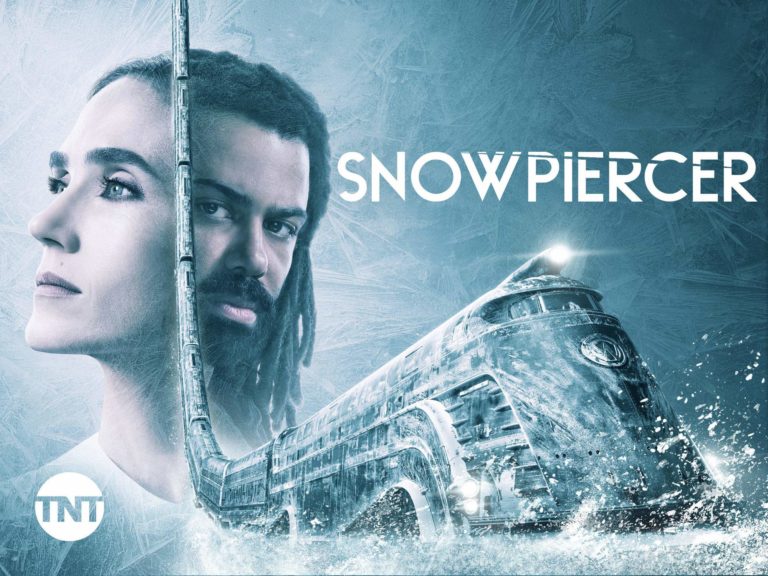Snowpiercer: The Eternal Engine Moves to the Small Screen
By: Theresa Krakauskas

While it’s been on TV rotation for a while now, it’s no surprise not many people saw Snowpiercer in a movie theater. When Harvey Weinstein (of all people) insisted on director Bong Joon-Ho cutting 25 minutes from his masterpiece, Joon-Ho ended up winning the editing war, but not the distribution. The film wasn’t given a national release, but Joon-ho was happy to keep his director’s cut. Now that his Parasite has gotten major attention and awards, Snowpiercer has been given a new incarnation as a TV series on TNT, Joon-Ho being one of the producers. The story originally comes from the 1982 French graphic novel Le Transperceneigea, a post-apocalyptic dystopian thriller. It takes place seven years after the world has frozen, due to wrong move in trying to stop global warming. The remaining survivors have boarded Snowpiercer, a train that runs eternally, circling the globe once a year, invented by the mysterious Mr. Wilford. The train has 1001 cars, and the survivors have been grouped into classes. The tail section houses the great unwashed, those who fought and grasped for a spot on the train, and the front section houses those who paid for a first class ticket. There are also second and third classes in between, which aren’t really seen in the film, but are more prominent in the series. All of the sections get some measure of comfort, with the exception of the tail, where they don’t even get a window. Every once in a while, the tail section stages a revolution, but they’ve never been successful. In the film, tail sectioner Curtis (Chris Evans) is the reluctant leader, who manages to make it where few men have gone before – the engine room at the front of the train.
Snowpiercer is one of my favorite films, but I was late to the TV party, only recently finding out about the series. I approached the series with both trepidation and excitement. It’s always a flip of the coin when a movie is translated to a television show. For every M*A*S*H and Buffy, there’s an Uncle Buck and a Dirty Dancing. On the other hand, I desperately wanted to see more of the train. For having so many cars, not many were shown in the film, but the ones that were, fascinated me. A sushi bar with a view of an aquarium that you could walk through, the sea life swimming in an arc above you; garden cars that held not only a meditative park, but a fabulous greenhouse; and a crazy party palace. That was reason alone for me to watch, but this series surpassed my expectations. Apparently, the it also had a rough start, having been in limbo since 2015, and while the first season has just wrapped up on TNT, you can catch it On Demand and binge as I did. Even better news, most of a second season has been filmed, although the release date hasn’t been announced. Those who expect a prequel or no revision of the story will be disappointed, as this is a total reboot, although some elements from the film have been kept intact. Daveed Diggs is the protagonist this time. In his old life, Andre was a homicide detective, and he’s the last one available. While planning a revolution, he’s recruited from the tail section to solve a murder in first class. Andre agrees, figuring this would be a good way to gather intel to help with his revolt. Diggs is an amazing actor; so good, that when Andre had his first sip of whiskey in God knows how long, I could taste it. Another familiar face is Jennifer Connelly as Melanie, head of Hospitality and the “voice” of the train. She’s also the go-between for Mr. Wilford, who reigns supreme along with his eternal engine, but is never seen. There’s also Annalise Basso, who I couldn’t place until I googled her, and found out she’d played the lead in Lifetime’s movie of V.C. Andrews’ Heaven. Steven Ogg, best known as Simon on The Walking Dead, has a recurring role as well.
The beginning narration, done by a different character each week, always reminds us that the cars number 1001, and I got my wish in seeing a lot more of them. In mirroring the film, while the front of the train dines on gourmet fare, the tail section gets protein blocks, which are made out of insects. (I’m sure pointing out that the tail section is probably getting a healthier diet would be no comfort to them.) Kronole, a toxic waste that gets people high by smelling it, is the drug of choice, and punishment is meted out in the same way for the tail section as it is in the film. When a tail sectioner commits an infraction of the rules, they’re forced to put their right arm out of a porthole and into the sub-zero temperature, until it can be shattered with a hammer. There’s nearly an entirely new cast of characters, Tilda Swinton’s original Minister Mason being split in two between Melanie and Ruth (Alison Wright), who worships the ground Mr. Wilford walks on. The train itself is a marvel, although the most unbelievable part of this television translation. In the film it was somewhat authentic, and much of it was shot in a space the size of a train. In the series, it’s like the Spice Girls bus in Spice World, where an entire mansion fits in a dimension smaller than my living room. While I could point to this as a flaw (and some have), I didn’t care. I can suspend my disbelief for a three-level nightclub. While not dependent on special effects, the show doesn’t skimp when necessary. You haven’t lived until you’ve seen a cattle car freeze when an avalanche smashes a hole in it.
Besides it being an all-around brilliant and entertaining show, it’s particularly relevant today. It’s order above all, and everyone should know and keep their place. There’s probably nowhere in the world without a caste system of some kind, whether created consciously or subconsciously, and while you’d think that would have dissolved as we’ve become more advanced, it’s never been more prevalent than right now. Snowpiercer’s first class passengers have it all, even in the most desperate of times; while the over-crowded, underfed tail section, literally hasn’t seen the light of day in seven years. They’re beaten by the guards, and passengers pulled out whenever one of their talents is needed in the front. Everyone has a preordained condition, because order and balance must be maintained. In the real world, we have that same ultra-rich 1%, often in positions of authority or power; and we have our own tail section, the people who struggle on the daily just to keep food on the table. They’ve frequently been kept in that position and held back by those in positions of power, as the top of the chain fears change. In the film, the very people who want to change the system are swallowed by it, but we’ve yet to see where they end up in the series. As Diggs said, “That’s one of the advantages of TV, you have time, so the politics that are hinted at in the film are explored in much more depth and the mechanism of the train [is explored further] – just the little things that create a world, world specificity”. While in Joon-ho’s Parasite, it’s debatable which class has the upper hand, it’s clear in Snowpiercer.
At the end of the film, the main characters conclude that to make a brave new world, most of the old one will have to be scrapped entirely, even if it means sacrificing themselves. Nothing else had worked anyway. I would imagine the hope of the series is to never come to a conclusion, but we’ll see what roads they take along the way. It’s hard not to wonder if what’s happening today – the significant number of deaths, and an uprising of the downtrodden – is leading us toward a brave, new world. Then again, since the film is set in 2031 and the freezing of the earth was based on a real plan, who knows? Maybe we’ll look back on these as the good old days.


